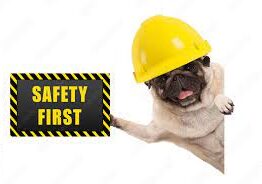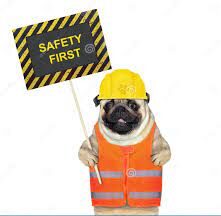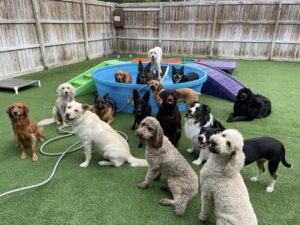Part 1 in Not All Dog Daycares Are Created Equal…Your Guide to Evaluating the Best Option for your Dog

Welcome to part one in our four-part series on how to evaluate and choose a dog daycare. This week we will focus on safety. Safety is a top priority at Play All Day and in my opinion, should be a top priority in any dog daycare. Most daycares will say that this is a top priority for them, but how can you really know for sure? Never fear, some expert tips are coming your way. We will look at facility design, processes, programming, and discuss how they can affect your dog’s physical and mental safety. The post is organized by topic, with questions to ask a prospective daycare and tips on what a good answer might be.
Fencing: Fencing should be secure to keep dogs in and to keep dogs from other playgroups out. Questions to ask regarding fencing.
- What material is the fencing made from?
- Ideally, fencing should be made of a solid non-see-through material such as wood or PVC. A chain link fence is more easily climbed and does not provide any type of visual barrier. Arousal levels are much higher when dogs have open vision to everything around them. It leads to barking and fence lunging in many cases. Managing arousal is one of the most important safety factors that a daycare should address. Excessive barking is a symptom of overarousal. More on this topic later.
- How high are the fences?
- Exterior fencing should be 8 feet high and have smooth sides so that dogs cannot scale or climb to escape. While daycare is fun for most dogs, there are times when a dog can become anxious. New dogs can take time to feel comfortable in a new environment. Escape can be a goal and it should not be easy for it to occur. Quality fencing of the right height and construction are imperative.
- Are there gates on the outside play areas?
- Outdoor play areas should not have gates. This is one of the non-negotiable safety factors for me. No matter how well-intentioned a facility is to make sure that gates are always closed and secure, there will come a time when something happens, and the gate is left open. So it is best to not have any gates on outside fencing.
Escape Prevention: Question to ask.
- How many doors and gates separate a dog from their playgroup and outside?
- In the dog daycare world, it is always best to imagine the worst-case scenario. What if a dog gets out of the play area or a crate? How many doors are between them and escaping to the outside? There should be multiple barriers to prevent this from happening. Two is my minimum. And there should be written policies on closing doors behind you.
Staff: This topic is so important to the safety and well-being of your dog; we will address it in its own blog post next week. But it is a key component of a safe daycare, so needs to be mentioned for this post. Next week, we will discuss the quantity and quality of the staff, but for today, we will address supervision only. Questions to ask.
- Will my dog be supervised 100% of the time when with other dogs?
- If the answer is anything but yes to this question, your dog will not be safe. Dogs in playgroups need eyes on them 100% of the time.
- Does the physical setup allow for the staff member to see all the dogs at the same time?
- For Play All Day, supervision is being in the same physical space with the dogs in our care. It is having an engaged staff member who is trained in dog body language and behavior, watching the dogs interact, listening to the tone of their play, and being within steps of all interactions. If there is an outdoor area, and the dogs are allowed to come and go freely from inside to outside, there should be a staff member inside and outside at the same time. Anything less is unacceptable.

Programming: This is another topic that is so important, it will also be its own post in a few weeks. But it plays a key role in safety so it must be mentioned here in those terms. In our post on programming, we will talk about the quality of programming and how it affects your dog’s experience. In this post, we will address the pertinent safety aspects of programming. I noted earlier, when discussing fencing, that managing arousal is important for a safe daycare. And just like good fencing can help to prevent over-arousal, so can good daycare programming. Having a program in place that manages over-arousal, manages barking, and inserts pauses and rest periods will decrease the chance of incidents that can lead to injury. Questions to ask.
- Will my dog get a break during the day?
- Breaks in the day from free play are beneficial in decreasing arousal levels. Short timeouts when a dog is over-aroused does wonders. And a scheduled naptime helps to prevent dogs from getting grumpy (toddler-tired).
- Does the staff intervene in dog/dog interactions?
- Staff intervention, quickly and efficiently, can help to prevent a dog fight. Something as simple as a staff member inserting a 10-second pause in play between two dogs can prevent it from going over the top and turning into a fight.
- Does the staff interact with and train the dogs?
- Training not only helps the staff to manage the dogs in playgroup but also decreases arousal by channeling energy and engaging the brain. And Bonus, your dog is getting trained!
- Are there crates in the play areas for timeouts?
- The ability to implement a quick crate timeout is crucial for managing a playgroup. If there are no crates available in the play area, staff cannot quickly implement a timeout.
- How is barking managed?
- Barking is a barometer of arousal levels. A quiet daycare is a sign of a well-managed daycare. This is an easy one to evaluate. Drive by a daycare during different parts of the day (but especially morning) and roll your window down. What are you hearing? An occasional bark here and there is not an issue (hey, we all must express ourselves), but constant barking is a sign that arousal levels are high and that there is no structure to the daycare.
- Is there a check-in and check-out window?
- It is a customer convenience to be able to drop off and pick up whenever you want, but is it in the best interest of all the dogs? Does it create a safe environment? The answer is no. Check-in is the most arousing part of a day at daycare and to have it go on all day keeps arousal levels high and unmanageable.
- Does the daycare require scheduled appointments?
- Scheduled daycare allows for careful consideration of what dogs go into each playgroup. It also allows the daycare to prevent over-booking and make sure staffing is adequate for the number of dogs attending. Drop-in daycare does not allow for structure and planning.
- Is there an attendance policy?
- Consistency in attendance plays such a huge role in safety. Sporadic attendance leads to higher arousal levels. Staff can spend most of their time dealing with behaviors from non-regular dogs and cannot focus on all the dogs in their care. Play All Day introduced a weekly attendance policy in 2012 and our incidents decreased dramatically.
Physical Space Per Dog: Question to ask.
- How many square feet per dog do you have in your play areas?
- Unfortunately, there is not an industry standard on this, but experience should teach any good daycare owner what this number should be. For Play All Day, we shoot for 75-80 square feet per dog in our big dog groups and 60-65 square feet per dog in our small dog groups. Our experience has taught us that exceeding these guidelines leads to overcrowding, increased arousal, and increased incidents between dogs. There are daycares in our area that will push this number to half of what we require at Play All Day. This is a question I would ask of any daycare I was considering sending my own dog to. To me, this is more important than the staff-to-dog ratio.
Dog/Dog Introductions: Those who already use daycare know how excited your dog is to get to daycare in the morning. This is the highest arousal time in a dog daycare. How the dogs are managed from the moment they walk through the door until they enter the playgroup is an indicator of how safe a daycare is. Questions to ask.
- Where does my dog go when I hand him off to you?
- Because this is such an exciting part of the day, it is up to the daycare to manage the arousal and help to deflate it a bit before introducing the incoming dog to the rest of the group. Play All Day uses a holding area to help dogs decompress over 5-10 minutes after arrival. This can be a crate in the hallway or the holding area just inside of the playgroup. How long is dependent on the dog arriving, the number of dogs already in the playgroup, and the tone of the group.
- How will my dog be introduced into the group?
- Dogs that are already in the playgroup may be crated during introductions, especially if they are over-exuberant greeters or have space issues. Once the arriving dog shows signs of relaxing, he is allowed into the playgroup and goes right to the outside area to relieve himself. The staff does not allow the dog to be mobbed as he enters. He then comes inside and if the staff feels that the energy level is appropriate, the dogs in crates are let out and allowed to greet gradually. The process only takes a few minutes but does wonders to decompress and make for safe greetings. Unfortunately, many daycares do not have a process for introducing arriving dogs to the playgroup and simply just let the dog into the group. This usually results in the dog being mobbed by the dogs already there and it is very stressful and arousing. Some dogs are just old pros and can manage this, but the average dog finds it overwhelming. It is not safe, and it is not in your dog’s best interest.
- Click here for a video on a healthy and safe dog introduction at PAD. And another one here.
New Dogs: Questions to ask.
- Do you review an enrollment form with the dog’s history before evaluating them in the daycare? Do you ask if the dog has been dismissed from other daycares?
- Play All Day has been teased about our enrollment form being so long and detailed and that most people did not have to provide so much information for their human child’s daycare. That is for a reason. The enrollment form gives us important information about the dog’s behavior and past. I would estimate that we can tell from the enrollment form alone, whether or not a dog is going to be a good fit, 75% of the time or more. And that information helps us to plan the dog’s introduction into the playgroup, so it will be successful and so that all the dogs will be safe.
- How do you physically introduce the new dog to the existing dogs in the daycare?
- We discussed how we introduce existing dogs into the group each week, but this is even more important when it is a new dog. This is a slow process and happens one-on-one with a trusted dog and one of the dogs is always on leash…most often both. All our new evaluations are scheduled at times when the daycare is not full yet. Extra staff is on hand to help manage the introductions and only our most skilled staff, trained specifically in introductions, perform this process.
- Click here for a video example of a safe new dog introduction at PAD. And Part 2 here.
- Do you deny entry to dogs that are inappropriate for a daycare setting?
- Not all dogs are a good fit for daycare. It is not fair to the dog who is not a good fit and it is not fair to all of the other dogs if the dog is allowed into the program. Daycares should have certain criteria that should be met for a dog to participate in daycare.
Incident Tracking: You can’t evaluate what you don’t measure. You can’t improve if you don’t evaluate. Questions to ask:
- Do you track incidents in your daycare?
- Incidents happen in any daycare, no matter how well-run it is. Dogs are living beings with personalities and just like us, life events affect them and their behavior. And some dogs will act out because of life changes (health issues, home changes, etc). The result can be a dog/dog incident. Most of the time these incidents are just a lot of noise and don’t result in injury. But sometimes they do. Both should be documented and evaluated, and parents should be notified.
- Do you routinely review the incidents and evaluate processes based on your findings?
- The documented incidents and close calls should be evaluated regularly to look for patterns. There is so much to learn by evaluating incidents. Many of our policies came from a careful evaluation of incident reporting. A few years ago, we had an outbreak of minor injuries related to the physical environment. They were from things like a gate latch that was wearing out, a crate wire that had rusted and broken away from the weld, and other small things like this. From this experience, we realized that our building was aging and that things were wearing down. As a result, we implemented monthly safety walkthroughs. Our Manager and Facility Supervisor walk through the buildings each month, looking for just these types of building wear and tear that could potentially affect a dog’s safety. Minor issues are addressed before they can cause an injury.
You made it through this long post. It most likely means that you are serious about finding the best option for your dog. Play All Day’s mission is to provide a fun, safe, and enriching environment for the dogs in our care. Safety is our highest priority. I wrote this post based on my experience with creating a safe dog daycare. There are many ways to accomplish this, but there are a few non-negotiable items. Not taking your dog to daycare is a better option than taking them to a daycare that does not have 100% supervision, a thorough enrollment process, and a safe dog introduction process. If you can’t find these, just walk away. Your dog will thank you.
I welcome your questions. Email me at april@playalldaydoggiedaycare.com 






